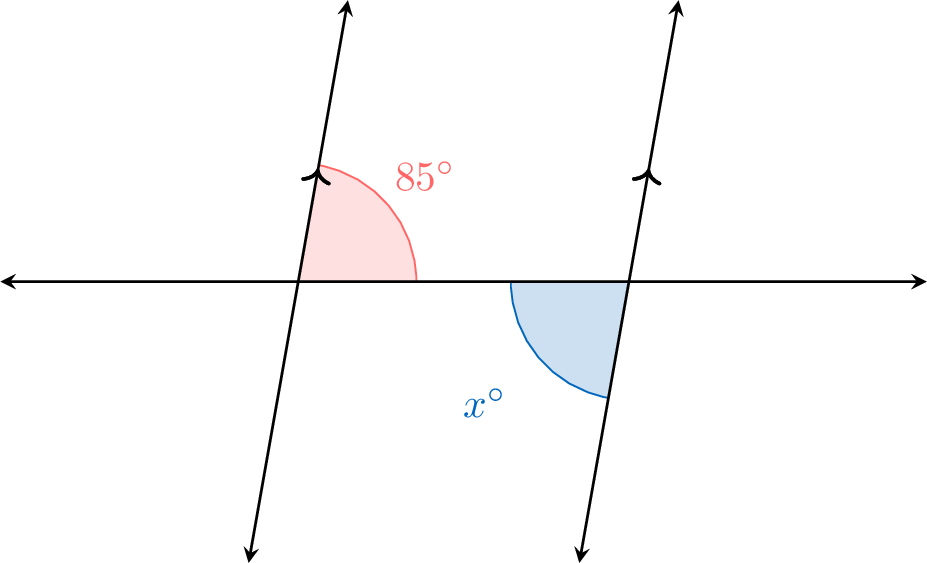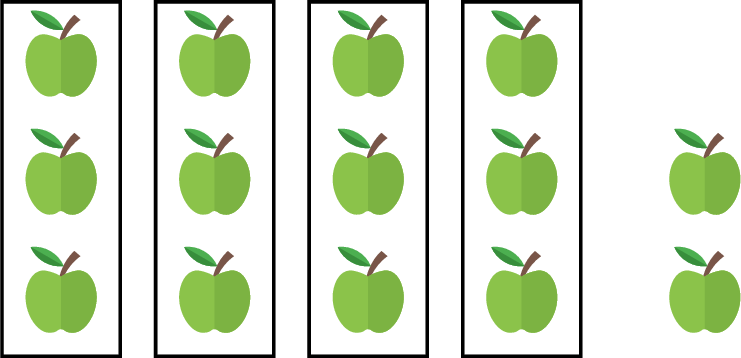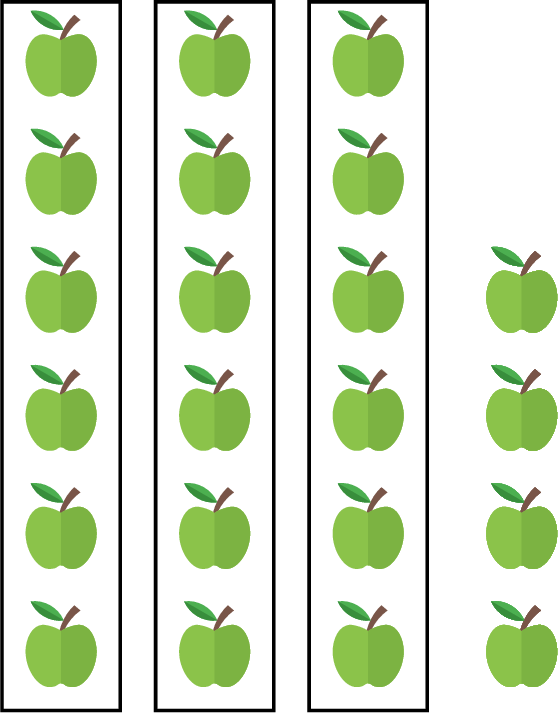Division with Remainders
Division with a remainder is a way of dividing when you don't have enough to make equal groups. It's like sharing things, and sometimes there's a little bit left over.
Division without Remainders
Definition Division
Division is
- splitting a total into equal groups:$$\textcolor{olive}{\text{total}} \div \textcolor{colordef}{\text{number of groups}} = \textcolor{colorprop}{\text{number in each group}}$$
- regrouping a total into groups of equal size:$$\textcolor{olive}{\text{total}} \div \textcolor{colorprop}{\text{number in each group}} = \textcolor{colordef}{\text{number of groups}}$$
Example
Hugo has \(\textcolor{olive}{6}\) marbles and he puts them into \(\textcolor{colordef}{3} \) equal groups. 
How many marbles are in each group?
There are \(\textcolor{colorprop}{2}\) marbles in each group.
Division with Remainders
Let's look at our marble example again. Now, Hugo has \(\textcolor{olive}{7}\) marbles and wants to make \(\textcolor{colordef}{3} \) equal groups. 
How many marbles are in each group? And how many are left over?

There are \(\textcolor{colorprop}{2}\) marbles in each group and 1 left over; this is called the remainder. We write $$\textcolor{olive}{7} \div \textcolor{colordef}{3} = \divionRemainder{\textcolor{colorprop}{2}}{\textcolor{orange}{1}}$$We can also write it as a multiplication plus the remainder:$$\textcolor{olive}{7} = \textcolor{colordef}{3} \times \textcolor{colorprop}{2}+\textcolor{orange}{1} $$
Definition Division with remainder
When you divide one number by another, sometimes there is something left over. The number that's left over is called the remainder.$$\textcolor{olive}{7} \div \textcolor{colordef}{3} = \divionRemainder{\textcolor{colorprop}{2}}{\textcolor{orange}{1}}$$We can also write it as a multiplication plus the remainder:$$\textcolor{olive}{7} = \textcolor{colordef}{3} \times \textcolor{colorprop}{2}+\textcolor{orange}{1} $$ 
Long Division
- To divide \(\textcolor{olive}{12}\) by \(\textcolor{colordef}{4}\), we write \(\textcolor{olive}{12} \div \textcolor{colordef}{4}=\boxed{\phantom{3}}\). Here's how to solve it:
- Think of the multiplication problem: \(\textcolor{colordef}{4}\times \boxed{\phantom{3}} = \textcolor{olive}{12}\)
- Find how many times \(\textcolor{colordef}{4}\) fits into \(\textcolor{olive}{12}\): \(\begin{aligned}\textcolor{colordef}{4}\times \textcolor{colorprop}{1}µ=\textcolor{olive}{4}¤\textcolor{colordef}{4}\times \textcolor{colorprop}{2} µ=\textcolor{olive}{8 }¤\textcolor{colordef}{4}\times \textcolor{colorprop}{3}µ=\textcolor{olive}{12 }¤\textcolor{colordef}{4}\times \textcolor{colorprop}{4} µ=\textcolor{olive}{16 }¤\textcolor{colordef}{4}\times \textcolor{colorprop}{5} µ=\textcolor{olive}{20 }¤\textcolor{colordef}{4}\times \textcolor{colorprop}{6} µ=\textcolor{olive}{24 }¤\textcolor{colordef}{4}\times \textcolor{colorprop}{7} µ=\textcolor{olive}{28 }¤\textcolor{colordef}{4}\times \textcolor{colorprop}{8} µ=\textcolor{olive}{32 }¤\textcolor{colordef}{4}\times \textcolor{colorprop}{9} µ=\textcolor{olive}{36 }¤\textcolor{colordef}{4}\times \textcolor{colorprop}{10} µ=\textcolor{olive}{40}\end{aligned}\), You can see that \(\textcolor{colordef}{4}\times \textcolor{colorprop}{3} = \textcolor{olive}{12}\)
- Answer: \(\textcolor{olive}{12} \div \textcolor{colordef}{4}=\textcolor{colorprop}{3}\)
- To divide with a remainder, like \(\textcolor{olive}{13} \div \textcolor{colordef}{4}=\divionRemainder{\boxed{\phantom{3}}}{\boxed{\phantom{1}}}\), we do something similar:
- Think of the multiplication problem: \(\textcolor{colordef}{4}\times \boxed{\phantom{3}}\)
- Find how many times \(\textcolor{colordef}{4}\) fits into \(\textcolor{olive}{13}\): \(\begin{aligned}\textcolor{colordef}{4}\times \textcolor{colorprop}{1} µ=\textcolor{olive}{4}¤\textcolor{colordef}{4}\times \textcolor{colorprop}{2} µ=\textcolor{olive}{8 }¤\textcolor{colordef}{4}\times \textcolor{colorprop}{3} µ=\textcolor{olive}{12 }¤\textcolor{colordef}{4}\times \textcolor{colorprop}{4} µ=\textcolor{olive}{16 }¤\textcolor{colordef}{4}\times \textcolor{colorprop}{5} µ=\textcolor{olive}{20 }¤\textcolor{colordef}{4}\times \textcolor{colorprop}{6} µ=\textcolor{olive}{24 }¤\textcolor{colordef}{4}\times \textcolor{colorprop}{7} µ=\textcolor{olive}{28 }¤\textcolor{colordef}{4}\times \textcolor{colorprop}{8} µ=\textcolor{olive}{32 }¤\textcolor{colordef}{4}\times \textcolor{colorprop}{9} µ=\textcolor{olive}{36 }¤\textcolor{colordef}{4}\times \textcolor{colorprop}{10} µ=\textcolor{olive}{40}\end{aligned}\), find the multiplication that gives an answer close to \(\textcolor{olive}{13}\), but not bigger.
- \(\textcolor{colordef}{4}\times \textcolor{colorprop}{3}=\boxed{12} \) is less than \(\textcolor{olive}{13}\)
- \(\textcolor{colordef}{4}\times \textcolor{colorprop}{4}=\cancel{16}\) is bigger than \(\textcolor{olive}{13}\)
- Calculate the difference: \(\textcolor{olive}{13}-\textcolor{colordef}{4}\times \textcolor{colorprop}{3}=\textcolor{orange}{1}\) which is the remainder.
- Answer: \(\textcolor{olive}{13} \div \textcolor{colordef}{4} = \divionRemainder{\textcolor{colorprop}{3}}{\textcolor{orange}{1}}\)
Method Column Division 1 Step
To divide with a remainder, like \(\textcolor{olive}{13} \div \textcolor{colordef}{4}=\divionRemainder{\boxed{\phantom{3}}}{\boxed{\phantom{1}}}\), follow these steps:
-
\(\begin{aligned} &\text{ }\text{ }\\\textcolor{colordef}{4} &\overline{\big)\textcolor{olive}{13}}\\\end{aligned}\) Set up the division problem -
\(\begin{aligned} &\;\text{ }\text{ }\text{ }\textcolor{colorprop}{3}\\\textcolor{colordef}{4} &\overline{\big)\text{ }\textcolor{olive}{13}}\\ &\,\text{ }\text{-}12\\\end{aligned}\) How many times does \(\textcolor{colordef}{4}\) fit into \(\textcolor{olive}{13}\)? We know that: \(\begin{aligned} \textcolor{colordef}{4}\times \textcolor{colorprop}{3} &=\boxed{12}\text{ which is less than or equal to }\textcolor{olive}{13}\\ \textcolor{colordef}{4}\times \textcolor{colorprop}{4} &=\cancel{16}\text{ which is bigger than }\textcolor{olive}{13} \\\end{aligned}\) Write \(\textcolor{colorprop}{3}\) above the line and the product \(12\) under the \(\textcolor{olive}{13}\) -
\(\begin{aligned} &\,\text{ }\text{ }\text{ }\textcolor{colorprop}{3}\\\textcolor{colordef}{4} &\overline{\big)\text{ }\textcolor{olive}{13}}\\ & \,\text{ }\text{ }\underline{\text{}12}\\ &\,\,\text{ }\text{ }\text{ }\textcolor{orange}{1}\\\end{aligned}\) Subtract \(\textcolor{olive}{13}-12=\textcolor{orange}{1}\) - \(\textcolor{olive}{13} \div \textcolor{colordef}{4} = \divionRemainder{\textcolor{colorprop}{3}}{\textcolor{orange}{1}}\) and \(\textcolor{olive}{13} = \textcolor{colordef}{4} \times \textcolor{colorprop}{3}+\textcolor{orange}{1} \)
Method Column Division 2 Steps
For the division with a remainder of \(\textcolor{olive}{130} \div \textcolor{colordef}{4}=\divionRemainder{\boxed{\phantom{32}}}{\boxed{\phantom{2}}}\), follow these steps:
-
\(\begin{aligned} &\text{ }\text{ }\\\textcolor{colordef}{4} &\overline{\big)\textcolor{olive}{130}}\\\end{aligned}\) Set up the division problem -
\(\begin{aligned} &\;\text{ }\text{ }\text{ }\textcolor{colorprop}{3}\\\textcolor{colordef}{4} &\overline{\big)\text{ }\textcolor{olive}{130}}\\ &\,\text{ }\text{-}12\\\end{aligned}\) How many times does \(\textcolor{colordef}{4}\) fit into \(\textcolor{olive}{13}\)? We know that: \(\begin{aligned}\textcolor{colordef}{4}\times \textcolor{colorprop}{2} &=8\\\textcolor{colordef}{4}\times \textcolor{colorprop}{3} &=\boxed{12}\leqslant \textcolor{olive}{13}\\\textcolor{colordef}{4}\times \textcolor{colorprop}{4} &=\cancel{16}\gt \textcolor{olive}{13} \\\end{aligned}\) -
\(\begin{aligned} &\;\text{ }\text{ }\text{ }\textcolor{colorprop}{3}\\\textcolor{colordef}{4} &\overline{\big)\text{ }\textcolor{olive}{130}}\\ & \,\text{ }\text{-}\underline{\text{}12}\!\downarrow\\ &\,\,\text{ }\text{ }\text{ }\textcolor{orange}{1}0\\\end{aligned}\) Subtract \(\textcolor{olive}{13}-12=\textcolor{orange}{1}\) and bring down the next digit -
\(\begin{aligned} &\;\text{ }\text{ }\text{ }\textcolor{colorprop}{32}\\\textcolor{colordef}{4} &\overline{\big)\text{ }\textcolor{olive}{130}}\\ & \,\text{ }\text{-}\underline{\text{}12}\!\downarrow\\ &\,\,\text{ }\text{ }\text{ }\textcolor{olive}{10}\\ & \,\text{ }\text{ }\text{ }\text{ }\text{-}\underline{8}\end{aligned}\) How many times does \(\textcolor{colordef}{4}\) fit into \(\textcolor{olive}{10}\)? We know that: \(\begin{aligned}\textcolor{colordef}{4}\times \textcolor{colorprop}{1} &=4\\\textcolor{colordef}{4}\times \textcolor{colorprop}{2} &=\boxed{8}\leqslant \textcolor{olive}{10}\\\textcolor{colordef}{4}\times \textcolor{colorprop}{3} &=\cancel{12}\gt \textcolor{olive}{10} \\\end{aligned}\) -
\(\begin{aligned} &\;\text{ }\text{ }\text{ }\textcolor{colorprop}{32}\\\textcolor{colordef}{4} &\overline{\big)\text{ }\textcolor{olive}{130}}\\ & \,\text{ }\text{-}\underline{\text{}12}\!\downarrow\\ &\,\,\text{ }\text{ }\text{ }\textcolor{olive}{10}\\ & \,\text{ }\text{ }\text{ }\text{ }\text{-}\underline{8}\\ &\,\text{ }\text{ }\text{ }\text{ }\text{ }\textcolor{orange}{2}\end{aligned}\) Subtract: \(\textcolor{olive}{10}-8=\textcolor{orange}{2}\) - \(\textcolor{olive}{130} \div \textcolor{colordef}{4} = \divionRemainder{\textcolor{colorprop}{32}}{\textcolor{orange}{2}} \)
Two Ways to Think About Division
Method Finding number in each group and remainder
If we know the \(\textcolor{olive}{\text{total}}\) quantity and the \(\textcolor{colordef}{\text{number of groups}}\), division tells us how many are in \(\textcolor{colorprop}{\text{each group}}\) and how many are \(\textcolor{orange}{\text{left over}}\):$$\textcolor{olive}{\text{total}} \div \textcolor{colordef}{\text{number of groups}} = \divionRemainder{\textcolor{colorprop}{\text{number in each group}}}{\textcolor{orange}{\text{leftovers}}}$$$$\textcolor{olive}{\text{total}} =\textcolor{colordef}{\text{number of groups}} \times \textcolor{colorprop}{\text{number in each group}}+\textcolor{orange}{\text{leftovers}}$$For example, we have \(\textcolor{olive}{14}\) apples and we share them equally among \(\textcolor{colordef}{4}\) friends.
Each friend gets \(\textcolor{colorprop}{3}\) apples.
There are \(\textcolor{orange}{2}\) apples left over.

Each friend gets \(\textcolor{colorprop}{3}\) apples.
There are \(\textcolor{orange}{2}\) apples left over.
Method Finding number of groups and remainder
If we know the \(\textcolor{olive}{\text{total}}\) quantity and the \(\textcolor{colorprop}{\text{number in each group}}\), division tells us how many \(\textcolor{colordef}{\text{groups}}\) we can make and how many are \(\textcolor{orange}{\text{left over}}\):$$\textcolor{olive}{\text{total}} \div \textcolor{colorprop}{\text{number in each group}} = \divionRemainder{\textcolor{colordef}{\text{number of groups}}}{\textcolor{orange}{\text{leftovers}} }$$For example, we have \(\textcolor{olive}{22}\) apples and we pack them in boxes such that each box contains \(\textcolor{colorprop}{6}\) apples.
We pack \(\textcolor{colordef}{3}\) boxes.
There are \(\textcolor{orange}{4}\) apples left over.

We pack \(\textcolor{colordef}{3}\) boxes.
There are \(\textcolor{orange}{4}\) apples left over.